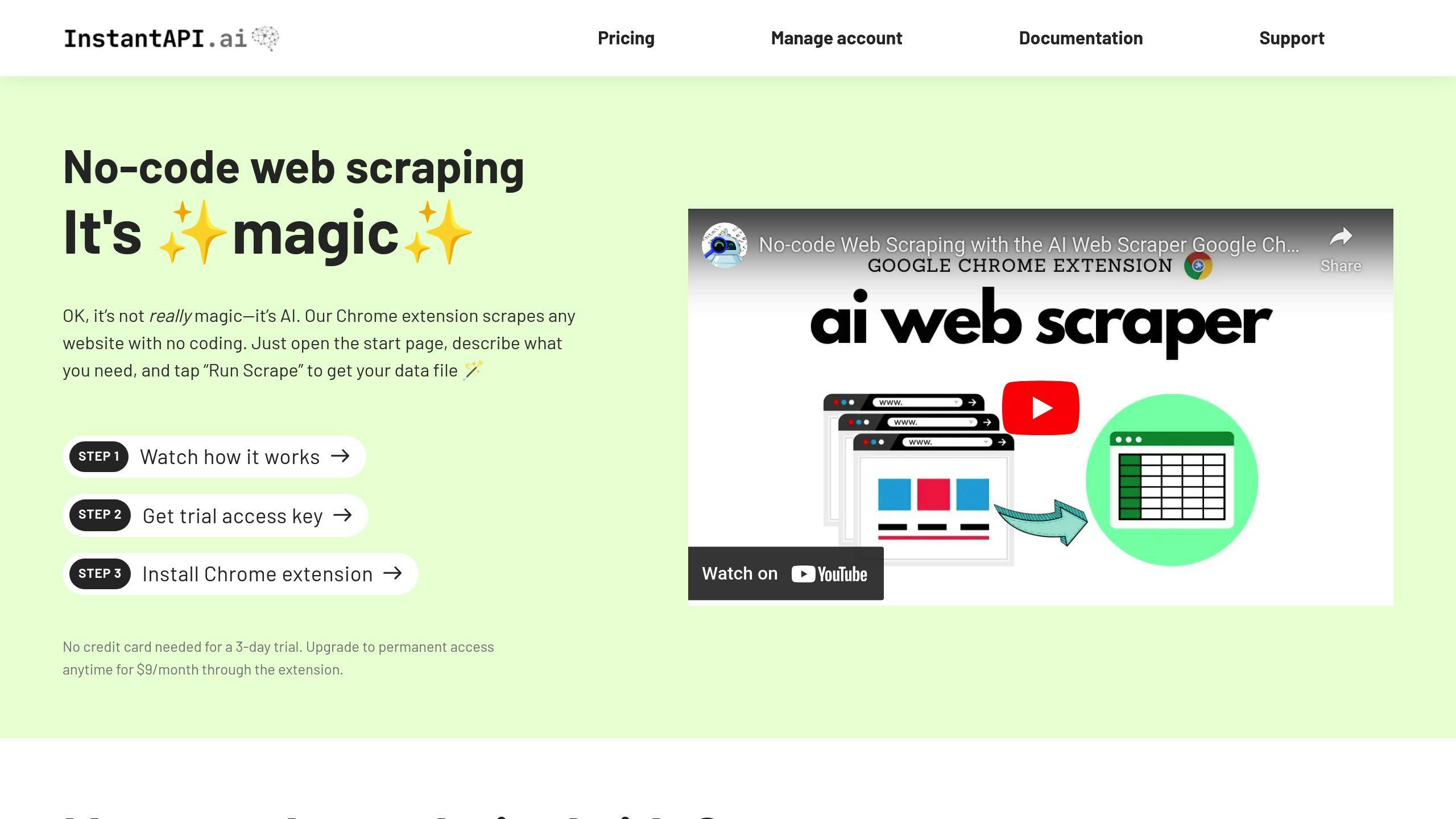Deep learning is changing how we extract data by solving problems like handling unstructured data, reducing manual updates, and improving scalability. Here's what you need to know:
- Challenges with Older Methods: Struggled with unstructured data, high maintenance, and limited scalability.
- Deep Learning Solutions: Neural networks (CNNs, RNNs) improve pattern recognition, NLP tools handle text better, and systems adapt over time.
- Key Tools: TensorFlow (scalable for enterprises) and PyTorch (flexible for research).
- Applications in Web Scraping: AI-powered tools process text, images, and dynamic content, automating complex tasks.
Deep learning makes data extraction faster, more accurate, and less dependent on manual intervention. Whether you're dealing with text-heavy documents or dynamic websites, these techniques are transforming the process.
Related video from YouTube
Deep Learning Techniques and Tools for Data Extraction
Deep learning has become the backbone of modern data extraction, addressing complex challenges with advanced techniques and tools.
Deep Learning Methods
Three key deep learning methods play a crucial role in data extraction, each excelling in specific areas:
Autoencoders for Feature Extraction
Autoencoders compress data while preserving essential features. Unlike traditional methods like PCA, they capture complex, non-linear relationships within data, making them highly effective for diverse data sources.
| Technique | Primary Use Case | Key Advantage |
|---|---|---|
| Autoencoders | Data Simplification | Non-linear feature extraction |
| CNNs | Visual Pattern Recognition | Automated feature learning |
| Pre-trained Language Models | Text Processing | Semantic understanding |
Visual Pattern Recognition with CNNs
CNNs (Convolutional Neural Networks) are designed to automatically detect features such as edges, shapes, and textures. This makes them ideal for analyzing image-heavy or visually intricate datasets.
Text Processing with Pre-trained Models
Pre-trained models like Word2Vec and GloVe improve the extraction of information from unstructured text by enabling a deeper semantic understanding.
Frameworks and Libraries Used
The choice of framework is critical for building and deploying deep learning models tailored to data extraction tasks:
| Framework | Strengths | Best For |
|---|---|---|
| TensorFlow | Scalable, production-ready | Large-scale enterprise applications |
| PyTorch | Flexible, dynamic computation | Rapid prototyping, research projects |
TensorFlow
TensorFlow is well-suited for production environments requiring scalability. Its distributed training capabilities make it a strong choice for enterprise-level systems.
PyTorch
PyTorch's user-friendly design and dynamic computation graphs make it a favorite for research and experimentation, allowing developers to quickly test and iterate on different model designs.
"The choice between TensorFlow and PyTorch often comes down to specific use cases. While TensorFlow dominates in production environments, PyTorch's ease of use makes it the go-to choice for rapid prototyping and research applications", explains a leading expert in AI-driven data extraction.
These methods and tools are paving the way for deep learning applications in tasks like web scraping, where their capabilities truly stand out.
Using Deep Learning in Web Scraping
Processing Unstructured Data
Deep learning has changed how unstructured data is processed in web scraping. Techniques like text embeddings (e.g., Word2Vec) help with semantic understanding, CNNs (Convolutional Neural Networks) are used for extracting visual data, and RNNs (Recurrent Neural Networks) handle sequential data like dynamic updates. Tools like TensorFlow and PyTorch provide the computational power required to implement these methods.
| Data Type | Deep Learning Solution | Advantage |
|---|---|---|
| Raw Text | Text Embeddings | Context-aware text interpretation |
| Images | CNNs | Automated visual data extraction |
| Dynamic Content | RNNs | Sequential data processing |
These approaches enable more advanced web scraping capabilities, including improved pattern recognition and automation.
Improving Pattern Recognition
Deep learning has taken pattern recognition in web scraping to a whole new level. Neural networks can uncover complex patterns in HTML structures, dynamic layouts, and data relationships - tasks that traditional scrapers often struggle with.
"The integration of deep learning models has revolutionized how we approach pattern recognition in web scraping. While traditional methods relied on rigid rules, AI-powered solutions can now adapt to dynamic content changes in real-time", explains Anthony Ziebell, founder of InstantAPI.ai.
With these advancements, deep learning makes it possible to:
- Automatically detect relevant content blocks
- Handle variations in website structures more effectively
- Adjust dynamically to layout changes in real-time
These capabilities not only improve accuracy but also simplify the overall process of extracting meaningful data.
Automating Data Extraction Tasks
Deep learning has turned repetitive data extraction into a fully automated process. AI-powered scrapers now handle complex scenarios that once required manual adjustments.
Take InstantAPI.ai as an example. Their system adapts to website changes, processes pages with JavaScript-based dynamic updates, and ensures high accuracy at scale. By integrating intelligent request handling and premium proxies, they demonstrate how deep learning can reduce the need for constant maintenance while delivering consistent results.
This level of automation has reshaped traditional scraping methods, allowing organizations to process massive amounts of data efficiently while maintaining high-quality extractions.
sbb-itb-f2fbbd7
Examples and Case Studies
InstantAPI.ai for AI-Driven Scraping

InstantAPI.ai showcases how deep learning techniques, like CNNs and RNNs, can streamline modern data extraction, offering a smarter approach to web scraping.
| Feature | Description |
|---|---|
| AI Data Extraction | Automates pattern recognition, removing the need for manual xpath setups and speeding up deployment |
| Premium Proxies | Manages distributed requests to ensure smooth data collection, even for high-demand projects |
| JavaScript Rendering | Handles dynamic content in real-time, making it possible to scrape modern web apps |
| Automatic Updates | Uses self-learning algorithms to adapt to website changes and maintain accuracy |
The platform is built to scale, with the Business plan supporting up to 45,000 monthly scrapes while delivering consistent results.
"Our AI-driven approach has fundamentally changed how businesses handle web scraping. By eliminating the need for manual configurations and constant maintenance, we've seen organizations reduce their data extraction costs by up to 50% while improving accuracy", says Anthony Ziebell, founder of InstantAPI.ai.
InstantAPI.ai highlights the impact of AI in web scraping, but other tools also bring distinct advantages, as seen in the comparison below.
Tool Performance Comparison
Leading AI-powered scraping tools differ in their ability to handle complex challenges:
| Tool | Key Capability |
|---|---|
| InstantAPI.ai | Simplifies pattern recognition without requiring xpath setups |
| Oxylabs' OxyCopilot | Bypasses anti-scraping defenses using advanced fingerprinting techniques |
| Bright Data's Web Unlocker | Excels at processing JavaScript-heavy content with advanced rendering capabilities |
Each tool leverages deep learning to address specific scraping challenges. For instance, Oxylabs' OxyCopilot uses neural networks for creating sophisticated fingerprints, while Bright Data's Web Unlocker specializes in extracting data from sites with heavy JavaScript content.
These AI-powered tools have revolutionized data extraction workflows, enabling faster and more precise results. Businesses using these solutions report major gains in efficiency and accuracy, showing how deep learning is transforming traditional web scraping practices.
Conclusion and Future Trends
Summary of Key Points
Deep learning has reshaped data extraction by bringing a higher level of automation and precision. Neural networks have made it possible to manage unstructured and complex data with impressive accuracy. Tools like TensorFlow and PyTorch have played a key role in automating tasks that once required manual effort, improving both speed and reliability.
For example, networks like CNNs (used for recognizing patterns) and autoencoders (used for extracting features) have transformed how data is processed and analyzed.
| Impact Area | Deep Learning Contribution |
|---|---|
| Accuracy | Reduced errors through automated pattern recognition |
| Efficiency | Faster processing of unstructured data |
| Flexibility | Ability to adapt to changes in data sources |
| Scalability | Better performance on large-scale extraction tasks |
As deep learning advances, it continues to open doors to new possibilities while also presenting unique challenges in the field of data extraction.
Future Developments and Challenges
The field of deep learning for data extraction is growing quickly. A major area of focus is improving model interpretability to build trust and reliability in AI-driven systems.
| Challenge | Description | Potential Solution |
|---|---|---|
| Ethical Issues | Privacy concerns and data usage policies | Develop AI methods that protect privacy |
| Complex Integration | Difficulties in implementing systems | Simplify frameworks for easier deployment |
| Transparency | Lack of clarity in AI decisions | Create tools for better model explainability |
Looking ahead, deep learning will likely offer even more advanced ways to handle complex data extraction tasks. These models will integrate more seamlessly with existing workflows, making them accessible to organizations of all sizes. At the same time, addressing key concerns like transparency, ethics, and ease of implementation will remain a priority.
FAQs
Here's a closer look at some of the top AI-powered tools and techniques for web scraping, building on the concepts discussed earlier.
Which AI tool is best for web scraping?
There are several AI tools designed to simplify web scraping by using advanced features like pattern recognition and handling dynamic content.
| Tool | Best For | Key Advantage |
|---|---|---|
| Import.io | Large-scale enterprise data | Strong API integration and automation |
| Parsehub | Smaller, desktop-based projects | Easy local setup with minimal effort |
| InstantAPI.ai | Automated maintenance | AI-driven extraction with minimal upkeep |
| Kadoa | Complex, unstructured data | Effective data cleaning and organization |
Among these, InstantAPI.ai shines for its automation features and flexible pricing, making it a practical choice for many users.
How to create an AI web scraper?
1. Define Your Goals and Pick the Right Tools
- Decide on target websites, specific data fields, and how you want the output formatted.
- Choose frameworks that suit your needs, such as TensorFlow for production or PyTorch for development flexibility.
2. Build and Implement
- Use proxies to avoid IP bans.
- Employ automated browsers to handle JavaScript-heavy websites.
- Train neural networks to recognize and extract the data patterns you're targeting.
3. Test and Refine
- Test your scraper across various data sources to ensure accuracy.
- Track performance metrics and tweak model settings for better efficiency.


